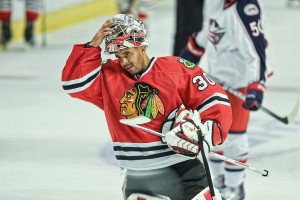Now with half the season in the rear view mirror, key stats make clear that a more physical Blackhawk defense could be the solution to their stalled championship run.

Off season acquisitions were intended to raise the grit of sandpaper around the Hawks blue-line. But hoping a value goaltender like Ray Emery can make it work after loading up the blue-line with pricey talent hasn’t worked for the Blackhawks so far.
Solving the rubrics of the Blackhawks struggles may seem obvious without crunching numbers. But the fix for the Hawks vividly comes into focus once you look at a few key defensive indicators:
HIT FACTOR
The Blackhawks system is self described as a high energy skill team and while hits aren’t everything they do paint a picture. The fact is that the Blackhawks have been outhit in every game this season with the exception of only five games.
Getting outhit can reflect a team’s possession time but that hasn’t been the case for the Hawk’s who’ve struggled controlling the puck.
Conventional wisdom in the NHL these days is to be strong on the forecheck and have your defense step into the other team when they’re trying to enter your zone. As an approach this wouldn’t put a tag for excessive physical play on the Blackhawks.
PENALTY KILL FACTOR
The Blackhawks have yielded 264 short-handed shots which is the 11th most this season. While the Hawks have been short-handed only 166 times—the sixth fewest—they’ve allowed far too many shots to reach their goalie.
One problem is that the Hawk’s defensemen don’t block shots—they focus on clearing the puck. The result is that the Blackhawks penalty kill has a 78.3 percent success rate and no team has won a championship in the NHL with less than an 81 percent success rate since 2001.
GOALS –AGAINST AVERAGE: 2.92
At even strength the Blackhawks have allowed 112 goals and have allowed an average 2.92 goals per game—25th in the league going into Monday.
No team wants to get scored against and while a high impact offense like the 2006 Carolina Hurricanes did overcome a 3.15 goal-against average, what says most about the goal-against average is that four of the last five Stanley Cup Champion teams were ranked in the top seven.
SHUTOUTS: ZERO
When the Blackhawks won the Stanley Cup in 2010 they had 11 regular season shutouts. With 29 games left in the regular season, the Hawks have zero shutouts and are the only team in the league without a shutout.
Here’s a look at the top ten defense payrolls in the NHL
| Team | Defense Payroll (Cap, Millions) | Goals Against Avg. (Through 2/7) | Goalie Payroll (Cap, Millions) |
| Philadelphia Flyers | 24.027* | 2.92 (25th) | 7.417 |
| Los Angeles Kings | 23.238 | 2.08 (3rd) | 3.05 |
| Winnipeg Jets | 22.743 | 2.72 (14th) | 3.00 |
| Washington Capitals | 22.562 | 2.83 (19th) | 2.65 |
| Phoenix Coyotes | 22.720 | 2.58 (11th) | 3.25 |
| Toronto Maple Leafs | 22.036 | 2.87 (20th) | 3.15 |
| Vancouver Canucks | 21.225 | 2.40 (7th) | 6.233 |
| Detroit Red Wings | 20.958 | 2.37 (6th) | 3.199 |
| Chicago Blackhawks | 20.830 | 2.92 (26th) | 3.267 |
| Calgary Flames | 20.345 | 2.64 (13th) | 6.696 |
THERE’S A TRADE DEADLINE APPROACHING:
As the trade deadline approaches it’s worth mentioning that the Blackhawks would only be responsible for the remaining cap on an acquired contract. The projected cap space for the Blackhawks is $5,151,338.00
In short, the Blackhawks have room to work as they would only be responsible for the amount owing under the acquired contract for the final 40 days rather than the full 185-day value.
This allows the Blackhawks—who are operating under the cap—to take on contracts of increasing value as the trade deadline approaches.
Conventional wisdom suggests that Stan Bowman invest heavily in a top defenseman and a goalie.